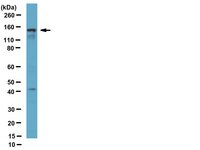06-1301 Sigma-AldrichAnti-TTF2 Antibody
Use Anti-TTF2 Antibody (Sheep Polyclonal Antibody) validated in WB to detect TTF2 also known as Forkhead-related protein FKHL15, hyroid transcription factor 2.
More>> Use Anti-TTF2 Antibody (Sheep Polyclonal Antibody) validated in WB to detect TTF2 also known as Forkhead-related protein FKHL15, hyroid transcription factor 2. Less<<Recommended Products
Overview
| Replacement Information |
|---|
Key Spec Table
| Species Reactivity | Key Applications | Host | Format | Antibody Type |
|---|---|---|---|---|
| H | WB | Sh | Serum | Polyclonal Antibody |
| References |
|---|
| Product Information | |
|---|---|
| Format | Serum |
| Control |
|
| Presentation | Sheep polyclonal serum containing 0.05% sodium azide. |
| Physicochemical Information |
|---|
| Dimensions |
|---|
| Materials Information |
|---|
| Toxicological Information |
|---|
| Safety Information according to GHS |
|---|
| Safety Information |
|---|
| Packaging Information | |
|---|---|
| Material Size | 100 µL |
| Transport Information |
|---|
| Supplemental Information |
|---|
| Specifications |
|---|
| Global Trade Item Number | |
|---|---|
| Catalogue Number | GTIN |
| 06-1301 | 04053252473562 |
Documentation
Anti-TTF2 Antibody Certificates of Analysis
| Title | Lot Number |
|---|---|
| Anti-TTF2 - NRG1637578 | NRG1637578 |
















